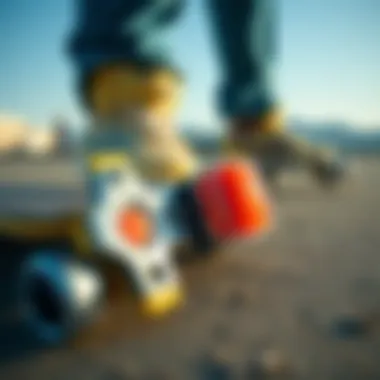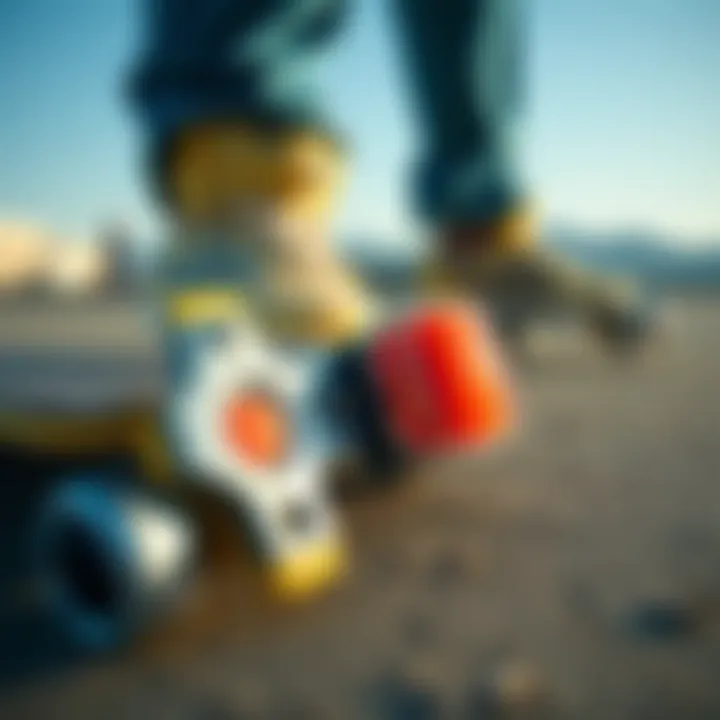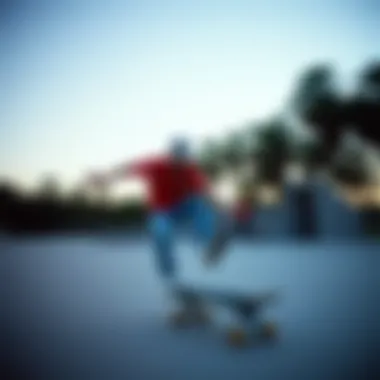The Evolution and Influence of Skateboarding Culture


Intro
Skateboarding has morphed from a niche pastime into a global phenomenon, capturing the hearts and minds of millions. Its evolution touches on various aspects of society—art, fashion, music, and even politics—making it a significant part of modern youth culture. What started as a simple wooden plank with wheels has come to represent a movement characterized by freedom, rebellion, and creativity. The culture surrounding skateboarding is not just about performing tricks on a board; it speaks volumes about community, self-expression, and breaking free from societal constraints.
As we dive into this exploration of skateboarding culture, we will look into the developmental stages of the sport, the iconic tricks that have been perfected over the years, and the gear that has evolved to improve performance and safety. Furthermore, we will look at how skateboarding has woven itself into the fabric of mainstream media, becoming a respected and celebrated activity on par with traditional sports.
This article aims to examine these aspects while providing insights on how individuals can develop their skills through effective learning and practice techniques. Additionally, we’ll delve into the favorite gear that skateboarders use today and how the right equipment can significantly enhance both performance and safety.
In doing so, our target audience—skateboarders, instructors, and shop owners—will find valuable information that resonates with their experiences, challenges, and aspirations within the skateboarding community. The following sections will illustrate how skateboarding, beyond being a sport, has become a vibrant culture worth exploring.
"Skateboarding is not just about the tricks you land; it’s about the life you live while riding on that board."
Through the journey ahead, we will highlight key points, develop a nuanced understanding of the impact of skateboarding, and recognize its significance in fostering creativity and unity among its participants.
The Genesis of Skateboarding
The genesis of skateboarding is not just a backstory of a sport; it's the foundation of a cultural phenomenon that has evolved and shaped youth identity across generations. This section reveals how the fusion of surfing and innovative thinking birthed a movement that transcends mere recreational activity. By understanding its origins, we gain insight into the cultural significance of skateboarding and its continuous impact on social dynamics and community building.
Origins in Surf Culture
Skateboarding traces its roots to the sun-soaked beaches of California in the late 1940s and early 1950s. Surfers longing for the thrill of riding the waves found an alternative on land. They took their surfboards and adapted them for use on concrete, resulting in the early versions of skateboarding. The concept was simple yet revolutionary: to mimic surfing’s fluid motion on solid ground, leading to the birth of sidewalk surfing.
"It was life in motion—an extension of our passion for the ocean, but it was also about the freedom of expression on asphalt."
— Former surfer, now professional skateboarder.
The first makeshift skateboards were little more than wooden planks with roller skate wheels. But this crude creation was like a spark in a powder keg, igniting the imagination of countless youths. These early days laid the groundwork for a subculture that emphasized individuality and rebellion against the norm. Such elements became the lifeblood of skateboarding culture—a blend of creativity, experimentation, and a touch of risk-taking, which resonated with the post-war youth of America.
The First Skateboards
In the early days of skateboarding, there wasn’t a standard model that every kid rode. Instead, the first skateboards were homemade and varied wildly from one creation to another. Some enthusiasts fashioned boards from old plywood, while others scavenged wheels from discarded roller skates. The lack of uniformity gave rise to distinct local styles, each reflecting the character of the riders and their neighborhoods.
By the 1960s, entrepreneurship took hold, leading to the commercial production of skateboards. Notably, companies such as Makaha and Logan Earth Ski began to market ready-made skateboards. These boards featured better materials and designs, sparking wider interest among the public. It’s important to note that this movement wasn’t merely about the boards; it was about the community that formed around them. The camaraderie and friendships forged during this era played a significant role in establishing the skateboarding culture we recognize today.
The Emergence of Street Skating
As the 1970s rolled around, skateboarding began its transformation from leisure activity to a full-fledged sport, driven by a desire for personal expression and urban exploration. With the rise of empty swimming pools and urban landscapes, skaters navigated concrete terrains, creatively adapting their styles to incorporate environments not traditionally meant for skating.
In urban settings, skaters began using streets, sidewalks, and abandoned structures for tricklining. This marked the dawn of street skating—a movement that transcended geographic and social boundaries, making skateboarding more relatable to everyday youth. The emergence of street skating redefined what it meant to be a skateboarder; it became about individuality, and flair, and often challenged societal norms. Innovative tricks like the ollie, developed in this period, formed the backbone of street skating and inspired new generations.
The Cultural Significance of Skateboarding
The significance of skateboarding stretches far beyond the simple act of riding a board. It's a cultural phenomenon that resonates with diverse groups, impacting social interactions, identity formation, and a sense of community. The evolution of skateboarding not only reflects trends in youth culture but also serves as a lens through which larger societal movements can be viewed. The importance of understanding this cultural significance lies in its ability to connect individuals from various backgrounds, showcasing the unifying power of a sport that often appears chaotic on the surface.
A Reflection of Youth Identity
Skateboarding has always been closely linked with youth culture, acting as a canvas for self-expression. Teens and young adults, often in search of identity, gravitate towards skateboard culture, using it as a means to explore personal style and social belonging. What makes skateboarding unique is its blend of artistry and athleticism. Each skateboard trick represents not just physical skill, but also creative expression.
The boards themselves, often adorned with vibrant graphics and stickers, serve as a personal extension of the rider’s personality. This aesthetic aspect fosters a sense of ownership, allowing skaters to showcase their individuality. Moreover, the community surrounding skateboarding often embraces alternative lifestyles, promoting values of inclusivity and openness. As skaters navigate punk rock sounds and urban landscapes, they form bonds that transcend typical friend groups. It creates a space where differences are celebrated, highlighting the rich tapestry of youth identity.
Skateboarding encourages young people to push boundaries, both physically and socially. Many skaters see themselves as renegades, challenging societal norms and expressing their discontent. This rebellion against convention can often translate into confidence and determination, qualities that serve young skaters well beyond their skateboarding years.
Political and Social Movements in Skate Culture
Skateboarding is also interwoven with various political and social movements. Over the decades, it has been a silent protest against societal constraints. For instance, the "Skateboarding is not a crime" movement arose in response to regulations prohibiting skating in public spaces. In this light, the skateboard evolves from a hobby to a tool for advocacy, as skaters rally for their right to skate in local environments.
Furthermore, many skaters actively engage in discussions surrounding social issues such as racial inequality and environmentalism. Events like skateboarding fundraisers and community skate days often draw attention to important causes. These gatherings not only raise funds but also increase awareness within the skating community. Skaters recognize their influence and use it strategically to mobilize around issues they care about.


"Skateboarding is as much about the culture you build with others as it is about the tricks you can land."
In recent years, skateboarding has also become more mainstream, entering realms like the Olympics. This inclusion not only changes perceptions but also crafts new conversations about representation and equity within the sport. Skaters from all walks of life are beginning to view this newfound spotlight as an opportunity to address broader societal issues, making the sport a catalyst for change.
Tricks and Techniques: The Art of Skateboarding
Skateboarding is not just a mode of transport; it’s an expression of individuality and skill. Tricks and techniques form the backbone of this culture. These moves are more than mere stunts; they reflect years of practice, creativity, and a deep connection to the skateboard itself. Getting the hang of these elements is key for anyone who wants to delve into skateboarding, whether for leisure or competition.
The importance of mastering tricks rests on numerous factors. Firstly, performing tricks boosts one’s confidence. Taking your board and landing a kickflip or an ollie can make you feel on top of the world. This confidence isn't limited to the skateboard; it transcends into daily life. Progressing through various techniques provides pathways for personal growth, which is vital for long-term engagement in the sport.
Secondly, tricks create a sense of community. When skateboarders gather, they often share tips, encourage each other, and celebrate successes, big or small. This camaraderie allows for the sharing of knowledge, refining skills, and fostering friendships. Additionally, some neighborhoods have local spots known for specific tricks, where newcomers can learn from seasoned skaters. Through these interactions, the culture thrives.
Finally, mastering tricks can open doors to other opportunities, like sponsorships or competitive events. It’s somewhat of a ladder; the more you advance, the more you can get noticed in the larger skateboarding community. Now, let’s break down the steps for beginners and then advance to those more experienced into the exciting realm of skate tricks.
Fundamentals for Beginners
Kicking off with the basics is critical for building strong foundations in skateboarding. For beginners, a simple understanding of fundamental tricks can dramatically enhance enjoyment and skill. The primary movements include the ollie, the kickflip, and the shove-it. Each of these tricks introduces vital techniques that form the basis for more complex feats.
- Ollie: Often considered the cornerstone of skateboarding tricks, the ollie involves popping the tail of the skateboard down while dragging the front foot upward. It’s crucial for jumping over obstacles and elevating any tricks that follow.
- Kickflip: This trick adds a flip into the ollie. As you pop the tail, use your front foot to flick outward, causing the board to rotate in the air. Mastery of this move opens the door to a variety of combinations.
- Shove-it: This trick involves spinning the board 180 degrees beneath your feet. While it may sound simple, timing and foot placement are key.
Starting with these fundamentals keeps frustration at bay. Beginners should practice in a safe space, away from crowded areas, to build confidence and control without the pressure of an audience.
Advancing to Intermediate and Expert Tricks
Once the foundational tricks are in the bag, the next step is honing more advanced techniques. Intermediate skaters often find joy in blending tricks for a unique style, experimenting with various combinations. Moves like the heelflip, nosebleed, and even the blunt slide challenge coordination and timing.
For those looking to progress further into expert territory, the stakes get higher. Think of jumps, grinds, and flips that require precision, like the 360 flip (a combination of a kickflip and 360-degree spin) and frontside smith grind. Mastering these tricks necessitates not only physical skills but also mental agility in terms of anticipating movement and controlling speed.
An environment that fosters learning cannot be overstated. Many skaters find that practicing at a skate park with varying obstacles stimulates creativity and innovation. Surrounding oneself with fellow skaters, each pushing the limits of their own skills, often ignites a fire to strive harder and achieve greatness.
As we look at the journey of mastering skateboarding tricks, it’s clear that each step taken, from fundamental to expert, plays a pivotal role in shaping a skateboarder's identity and potential. With perseverance and a willingness to learn, anyone can master the art of skateboarding.
The Evolution of Skateboarding Gear
The journey of skateboarding gear reflects the broader evolution of skateboarding itself, showcasing how advancements in technology and design have elevated the sport. When first introduced, skateboards were rudimentary contraptions with limited functionality. As skateboarding grew in popularity, so did the demand for better equipment, leading to innovations that have dramatically improved performance and safety.
Innovations in Skateboard Design
The development of skateboards has come a long way from the wooden planks with metal wheels of the past. Today, a skateboard’s design often features a complex interplay of materials and shapes that cater to various skating styles.
- Material Upgrades: Modern skateboards typically use materials like maple wood, fiberglass, and carbon fiber, each offering different flexibilities and weights that influence performance. For instance, maple has long been the go-to for its sturdiness, while carbon fiber is favored for lightness and resilience.
- Deck Shape Evolution: The shape of skate decks has transformed significantly as well. While original boards were mostly flat, contemporary designs range from popsicle shapes to cruiser decks. Each variation is tailored for specific tricks or cruising, demonstrating a clear link between design and the type of skating.
- Wheel Technology: Wheel construction has also progressed, now often comprising urethane for a blend of durability and grip. Riders can choose from various durometers (hardness levels), allowing personalized riding experiences depending on surface types and skating conditions.
"The right board can make all the difference—it feels like an extension of your own body."
Safety Equipment and Its Importance
With the rise of skateboarding as both a sport and lifestyle choice, safety gear has become pivotal.An ounce of prevention is worth a pound of cure. Skaters not only engage in tricks but do so in increasingly complex and unpredictable environments. Proper safety equipment is essential for minimizing risks associated with falls or collisions.
- Helmets: A non-negotiable piece of gear, modern helmets emphasize lightweight design paired with advanced impact absorption materials. Look for those that meet safety certifications for maximum head protection.
- Protective Pads: Elbow and knee pads are not just stylish—they’re critical for skaters, especially beginners who may fall often. Innovations in materials offer better comfort and mobility, making them easier to wear for extended periods.
- Shoes: Skate shoes have evolved to include features like reinforced stitching and rubber soles that provide better grip on the board. Particular brands have prioritized this, understanding that comfort during trick execution is just as critical as style.
The Impact of Brand Culture
Brand culture in the skateboarding realm cannot be overlooked. Companies like Vans, Element, and Anti-Hero have cemented themselves more than just gear distributors; they’ve become cultural icons. These brands are steeped in the history of skateboarding and often serve as symbols of identity.
- Authenticity and Image: Each brand curates an image that appeals to certain demographics within the skateboarding community. For instance, streetwear brand Supreme leverages its high-profile collaborations to infuse skate culture with luxurious appeal, while more traditional brands focus on raw talent and underground aesthetics.
- Influence of Sponsorship: Professional skateboarders often partner with brands, turning them into household names. This not only helps in promoting gear but also molds the landscape of skate culture. Skaters like Nyjah Huston and Tony Hawk exemplify how endorsements can drive brand evolution and visibility.
- Grassroots Movement: Besides mainstream brands, countless small-scale companies thrive, many run by skaters themselves. Their focus on niche markets helps promote alternative styles and fosters a sense of community, providing unique options that appeal to different tastes.


Skateboarding in Mainstream Media
Skateboarding in mainstream media has evolved from being a niche subculture to a dominant force that shapes perceptions across generations. The rise of skateboarding in films and documentaries has not only popularized the sport but also woven its narrative into the fabric of youth culture. This inclusion has provided a platform for skateboarders to express themselves and their stories, making it crucial for both skaters and enthusiasts to recognize its significance.
One striking aspect of skateboarding's rise in mainstream media is its ability to reflect societal changes. From the gritty streets captured in early documentaries to polished productions seen today, skate videos have transformed into art forms, showcasing talent while influencing fashion and music. The skateboard community has adeptly navigated the changing landscape of media, utilizing it not just for visibility but to create a cultural dialogue around important issues.
Documentaries and Films That Shaped Perception
Films and documentaries have played an irreplaceable role in shaping the perception of skateboarding. Dogtown and Z-Boys, for instance, offered a raw glimpse into the early days of skateboarding, highlighting the lives of the Zephyr skateboard team. The film not only focuses on the sport, but it also shines a light on the cultural and environmental factors influencing these young skateboarders. This piece, along with Lords of Dogtown, created a moment for skateboarding, embedding its essence in popular culture.
"The skateboarding experience is like capturing a lightning bolt in a bottle. Film gives those moments a permanence many of us seek."
Additionally, the documentary The Art of Flight propelled skateboarding into the realm of extreme sports, giving viewers a taste of adrenaline and the breathtaking visuals that accompany it. With spectacular cinematography, it redefined not only how skateboarding is perceived but also influenced how brands market their products, leading to collaborations that leverage both sport and film.
Social Media Influence on Skate Culture
In today's digital era, social media acts as the lifeline of skate culture, allowing it to thrive and diversify in unprecedented ways. Platforms like Instagram and TikTok have transformed the way skateboarders share their craft. It serves as both a gallery and a studio where new tricks, styles, or even inspirational moments can be broadcasted to a global audience literally in seconds.
Punchy videos, thrilling edits, and engaging content have become staples for up-and-coming skaters and established pros alike. Skate legends such as Tony Hawk and Nyjah Huston utilize these platforms to connect directly with their followers, offering insights into their lives beyond the board. This creates a community where ideas flow, fostering creativity and igniting trends at lightning speed.
Moreover, social media platforms have gave rise to movements within the community, advocating for inclusivity and support for upcoming skateboarders, especially marginalized voices. Skateboarding competitions streamed live online allow fans from all over to give their support and cheer on their favorites even without being there in person. This element of connectivity holds profound implications for the future of the sport, further solidifying skateboarding's presence in mainstream culture.
Skate Parks: Where Community Grows
Skate parks serve as the beating heart of skateboarding culture. They are not just concrete structures with ramps and rails; they are vibrant spaces where enthusiasts from all walks of life gather. The essence of skateboarding—individuality, creativity, and perseverance—thrives in these local hubs. In the context of community, skate parks play a crucial role in fostering connections among skateboarders, providing a safe environment, and encouraging the sport's growth. By offering designated areas for practice and innovation, skate parks help young skaters develop skills while building friendships that span generations.
Design and Functionality of Skate Parks
The design of skate parks often reflects the local culture, catering to the community’s needs and preferences. A well-planned skate park should include a variety of features: ramps, bowls, ledges, and street-like obstacles. These elements encourage different styles of skating, from street to vert. Additionally, a thoughtfully-designed skate park will include spaces for spectators, providing a social focal point.
Accessibility is another important consideration. Elements like smooth surfaces and easy ramps can make a park welcoming for beginners while also posing challenging obstacles for seasoned skaters.
Some skate parks include design features like the following:
- Flow Tracks: Promote continuous skating, allowing riders to gain speed and flow from one element to another.
- Vert Ramps: Cater to high-flying tricks and attract skaters looking to push their limits.
- Street Courses: Mimic urban environments, blending in ledges, curbs, and stairs that real-world skaters use.
By incorporating these elements, parks can become not only functional but also inspirational spaces that invite creativity and exploration.
The Role of Skate Parks in Local Communities
Skate parks often serve as a microcosm of the larger community, reflecting its values and providing a place for collaboration. They carve out safe havens where youth can engage in a constructive activity. Skaters often come together to contribute to the park's upkeep or to organize events and competitions. This sense of ownership fosters pride and enhances community bonds.
Moreover, skate parks can also act as a platform for local social issues. Many parks host events that highlight fundraising efforts or awareness campaigns for specific causes. These events not only provide enjoyment but also unite individuals around shared objectives.
Some benefits of skate parks in local communities include:
- Youth Empowerment: Providing kids and teenagers a constructive avenue for self-expression.
- Social Spaces: Creating environments where skaters can mingle, fostering friendship and camaraderie.
- Community Events: Hosting competitions or local festival days that encourage community engagement.
“A skate park is more than just a place to skate; it’s a place that builds friendships and creates memories.”
Challenges in the Skateboarding Community
The skateboard community, with its unique culture and vibrant spirit, faces several challenges that merit attention. These challenges shape the way the sport is perceived and practiced, affecting skateboarders from all walks of life. It’s not just about doing tricks and showing off skills; the issues that surround skateboarding can sometimes put a damper on the fun and camaraderie that characterize the activity. This section aims to explore the significant hurdles within the community, particularly concerning safety and legal matters.
Addressing Safety Concerns


Safety is at the forefront of any discussion when it comes to extreme sports like skateboarding. The daring stunts and complex tricks that skateboarders perform can lead to injuries, some of which are severe. The statistics paint a stark picture: over 50,000 skateboarders visit ERs in the United States each year due to injuries ranging from sprains to fractures.
Here's why addressing safety is crucial:
- Safety Gear: Wearing helmets, knee pads, and elbow pads is vital for minimizing injuries. Many skaters, especially the younger crowd, tend to dodge this gear due to fashion influences or perceived toughness. Yet, prioritizing safety doesn’t make one soft; it enhances the ability to skate longer and get better.
- Awareness: Educators and community leaders must focus on creating awareness about the risks involved. This could include workshops and seminars that provide insight into safe skating practices and techniques on how to fall – yes, there is a right way to fall! Like they say, "better safe than sorry."
- Community Support: Local skate parks are integral in raising safety standards. Providing ample space for different skill levels and ensuring obstacles are well-designed can significantly reduce risk. Keeping communication open among skaters about potential hazards fosters a safer environment, where everyone looks out for one another.
"Safety is no accident."
By making safety a shared priority, the skateboard community can thrive without fearing the fallout from reckless moves.
Legislative Issues Surrounding Skateboarding
Laws and regulations are often a tricky landscape for skateboarders. Many cities see skateboarding as a nuisance rather than a form of artistic expression or sport. This perspective can lead to ordinances that restrict skating in public spaces, turning vibrant skate spots into no-go zones. Understanding the intricate relationship between legality and skateboarding is essential for the future of the sport.
Key legislative issues to consider include:
- Public Spaces: Many skateboarders often find themselves skating in places like plazas or parks—areas that aren't always meant for such activities. Regulations can lead to tensions with both local authorities and business owners, who may view skaters as disruptive. Advocacy for designated skate areas is crucial for maintaining harmonious relationships.
- Insurance and Liability: Skate parks and shops often shy away from offering facilities or sponsorships due to liability concerns. Lawsuits arising from injuries can pose significant risks for anyone involved. Advocacy for legislation that protects park owners and sponsors introduces security into the equation, ultimately encouraging more investment in skateboarding infrastructure.
- Youth and Accessibility: Children might find it harder to access safe facilities due to legislative barriers. Advocacy groups can play a part in campaigning for more inclusive policies, which can expand the horizons for young skaters. A community that supports each other in overcoming bureaucratic hurdles strengthens the fabric of skateboarding.
The ongoing evolution of skateboarding culture relies heavily on the community’s ability to navigate these challenges. By addressing safety concerns proactively and getting involved with local legislation, skateboarders can work toward a future where the sport receives the recognition and respect it truly deserves. The legacy left behind can inspire not just current skateboarders but also generations to come.
The Future of Skateboarding
As skating rolls into new territories, both figuratively and literally, the future of skateboarding looks to be a tapestry woven with change, challenge, and creative opportunities. Over the past few decades, the horizon has shifted significantly—from ugly duckling to a celebrated sport embraced by the mainstream. This upcoming phase involves not just trends and styles but also the deeper implications of community dynamics, accessibility, and recognition in the athletic arena.
Olympic Inclusion and Its Implications
With skateboarding’s debut in the Olympics at the Tokyo 2020 Games, a whole new ball game opened up. Not only did it lend skateboarding a sense of legitimacy, but it also placed the sport under the scrutinizing gaze of global audiences. For professional skateboarders, this spotlight could mean endorsements, sponsorships, and a surge in popularity they’ve long desired. However, it also raises questions about authenticity and identity. Will skaters remain true to their roots, or will the pressure to conform to Olympic standards dilute the raw expression that characterizes skateboarding?
- Opportunities for Athletes
Skaters now have pathways to recognition that include scholarships and professional contracts. - Commercial Impact
The increase in viewership is likely to attract brands eager to invest in this growing market. - Youth Engagement
Inclusion could inspire a new generation of skaters; schools might even incorporate skateboarding into their sports programs.
Despite these potential benefits, there's a persistent worry within the community. Many fear that skateboarding might become sanitized, losing its edge and rebellious spirit. The evolution from a counter-culture to an Olympic sport implies a clash of values. So, while the medals shine bright, it's vital to remember the heart of skateboarding lies in freedom and creativity.
Evolving Trends in Skateboarding
Skateboarding is far from stagnant; it’s a living entity, always morphing to accommodate changing times and societal shifts. The future also holds exciting prospects in terms of technology and culture.
- Innovative Gear
From electric skateboards to smart helmets that can track performance, advancements in technology are enhancing the riding experience. Companies are focusing on sustainable materials and eco-friendly designs as environmental concerns rise. - Diverse Styles and Influences
The blending of styles is creating a melting pot of techniques and tricks. Skateboarding is now influenced not just by other sports but also by music, fashion, and even street art. - Increased Inclusivity
The culture is slowly becoming more inclusive, welcoming skaters from all backgrounds, regardless of gender, race, or age. Initiatives are being developed to encourage more participation, breaking down barriers that historically might have barred entry.
As we speed into the future, the next evolution of skateboarding culture will not only celebrate its roots but also embrace growth and innovation. The fusion of art, sport, and community remains vital; it shapes the experience for newcomers and seasoned veterans alike.
"For us, skating is more than just an activity—it's a way of life. As the lines blur between street and sport, we hold dear the essence of freedom and expression.”
Final Thoughts on Skateboarding Culture
The evolution of skateboarding culture is not just a narrative about tricks and boards; it's a profound reflection of societal changes, creative expressions, and community building. Within this article, the significance of skateboarding culture transcends the act of skating itself, encapsulating a unique blend of resilience, innovation, and identity.
Skateboarding serves as a mirror to the youth of each era. It embodies their struggles, aspirations, and the indomitable spirit that drives them to push boundaries. The melding of art and sport, manifested in personalized styles, tricks, and even the aesthetic of skate parks, showcases an evolving identity that resonates with new generations. It isn’t just about the grind on a rail or the perfect ollie; it’s about the lifestyle, the culture, and the tight-knit communities that grow around them.
The Enduring Spirit of Skating
Skateboarding represents not merely a pastime but an enduring legacy of ambition, self-expression, and camaraderie. The spirit of skating is characterized by the pursuit of freedom and creativity. It has long been a form of rebellion against conventional norms, allowing individuals to carve their paths and express themselves uniquely. As skaters navigate urban landscapes, each grind and flip is a testament to their relentless pursuit of mastery and innovation.
Key Aspects of the Enduring Spirit of Skating:
- Creativity: Each skater brings a personal flair, turning routines into performances and skate parks into canvases.
- Community: Skateboarding fosters connections among diverse individuals, breaking down barriers and creating space for collaboration and friendship.
- Resilience: Skaters learn to embrace failure, understanding that falling is just a part of the journey. Each bruise is a badge of honor, offering lessons that extend beyond the skateboard.
"Skateboarding is about finding your rhythm, whether it's the sound of wheels hitting concrete or the silence of a perfect landing."
Skate culture continually adapts, breathing new life into its traditions while embracing change. With the advent of technology and social media, the landscape has transformed dramatically. Skate videos propagate styles, tricks, and philosophies, connecting skateboarders globally. This community-driven, digital age allows skaters to share their narratives, further enriching the culture.
Moreover, the recent recognition of skateboarding in events like the Olympics signifies its growing importance and acceptance. Such developments challenge preconceived notions and pave the way for inclusion, inspiring more people to engage with the sport. As skateboarding continues to grow and evolve, it remains a powerful symbol of youth empowerment and cultural significance.
In summation, the enduring spirit of skateboarding culture is rooted in the values it promotes – creativity, community, and resilience. These elements not only shape the experience of being a skater but also offer broader lessons in life, making skateboarding a timeless emblem of self-discovery and expression. The path forward is bright, with countless opportunities for new voices and perspectives to emerge, solidifying the place of skateboarding in the tapestry of contemporary culture.



